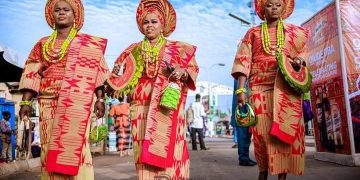Egedege N’Okaro is an ancient storey-building in Benin Kingdom. Built in 1906 by High Chief Osawe Iyamu, the then Inne of Benin, widely regarded as the second oldest story-building in Nigeria after the first one at Badagry, Lagos built in 1845 by white missionaries. Egedege N’ Okaro is Situated at House No 30, Erie Street,off Sakponba Road, in ancient city of Benin. According to historical accounts, Egedege N’Okaro was the first residential one-storey structure to be built in the ancient city. It is made of red furnace-fired bricks with wooden decking. The design of building was given to Chief Iyamu by a Briton, Mr. Crawe Reade, a colonial officer who supervised its construction.
A similar structure used as a ware-house was built by the Dutch in 1720 at Ughoton, a sea port. It was destroyed in 1767 by the French, according to historical accounts.
Although it was said that Chief Iyamu was not the first to start the construction of a storey-building, he completed his first. After his came the two, owned by the late Chief Eson Orokhiri and Prince Usuanlele Ovonramwem, on Ibiwe Street in Benin.
Interestingly, Egedege N’Okaro is a representation of the period in which it was built. The British had come with new things, ideas and new inventions were coming in.
More than hundred years old ,the structure still stands firmly and majestically.
What then is the secret behind the sturdiness of Egedege N’okaro over the years? Certainly, its builders were skilled masons who had their acts well articulated and executed with competence, thus ensuring the durability of the building.
The bricks of red earth used to build the structure were fired for three months and cooled for two weeks in the valley in the present Ikpoba Slope in Benin city . Its wooden decking and roofing were made of timber from choice trees – Mahogany and Iroko of about hundreds of years.
The signboard with the inscription: the Centenary Celebration of Egedege N’Okaro (the first storey-building in Benin Kingdom ) advertising its uniqueness alongside the address of the place cannot be missed by any passers-by. The wall fencing has Benin traditional designs. On closer examination, Egedege N’Okaro has an oriental appeal. By the porch on the ground floor are six huge roman columns painted red with some artistic designs. At the main entrance into the building with two wooden carved doors is a flower decoration. It has arch-shaped windows which delineates the oriental feel.
Its dimension is 48ft by 30ft and the height is same with any modern storey-building. On the ground floor is the main parlour with four adjoining-rooms – two on each side – which are also replicated upstairs. The wooden railing on the staircases and the top veranda, windows and carved door lentils are intact and in its original state, untouched by termites. In the sitting room upstairs, an electric fan and the chandelier lighting installed a long time ago are still functioning.
On the side of the building are two bungalows. The bungalow on right, built by the Ize-Iyamu progenitor, Chief Ohenwen, is two hundred years old. It was one of those spared when the British attacked the city.
On the other side is a small attachment housing a sitting room decorated like a mini-palace. In it, is a throne with the painting of the Esogbon of Benin kingdom over it and two wooden, red-rugged steps in front as foot mats. Hung on the left wall is the picture of the Oba of Benin and on the right is that of the Esogbon. Still on the right are the picture of Chief Iyamu and a painting of Egedege N’Okaro by Benin artist Omoruyi. Also scattered on the walls in the room are pictures of every member of the family. There are chairs belonging to varying generations; they are of modern and traditional blends – crafted wooden chairs as well as the present day sofa. On the one end of the room is a door that opens up into a square-shape courtyard at the back of the house hedged in by part of the old building, the harem belonging to wives and the kitchen. The courtyard was used for receiving visitors for private family meetings, the practice has since not stopped.
Credit: Facebook/Edo people entertainment








































